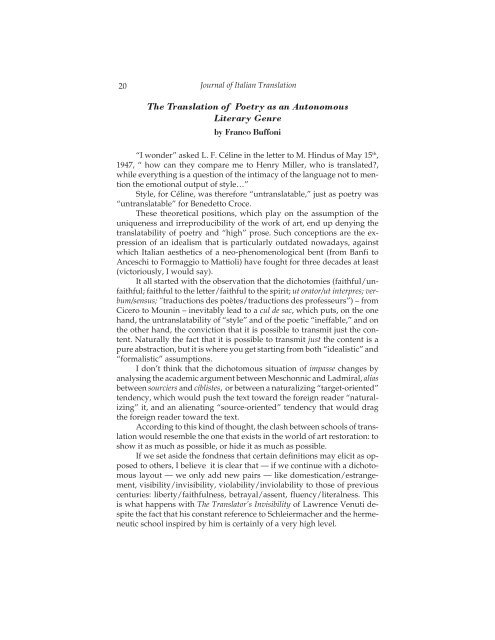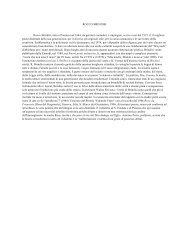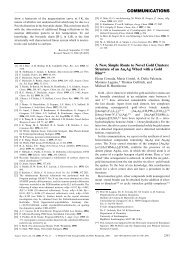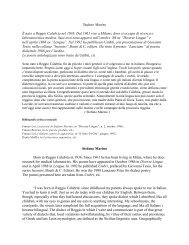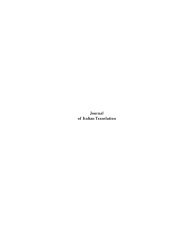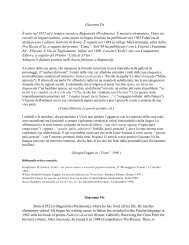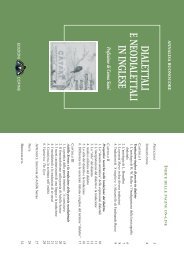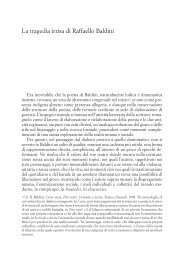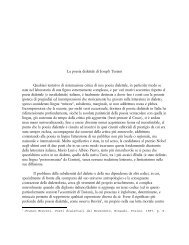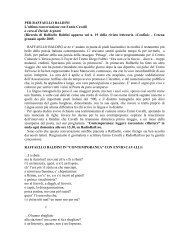Journal of Italian Translation
Journal of Italian Translation
Journal of Italian Translation
You also want an ePaper? Increase the reach of your titles
YUMPU automatically turns print PDFs into web optimized ePapers that Google loves.
20<br />
<strong>Journal</strong> <strong>of</strong> <strong>Italian</strong> <strong>Translation</strong><br />
The <strong>Translation</strong> <strong>of</strong> Poetry as an Autonomous<br />
Literary Genre<br />
by Franco Buffoni<br />
“I wonder” asked L. F. Céline in the letter to M. Hindus <strong>of</strong> May 15 th ,<br />
1947, “ how can they compare me to Henry Miller, who is translated?,<br />
while everything is a question <strong>of</strong> the intimacy <strong>of</strong> the language not to mention<br />
the emotional output <strong>of</strong> style…”<br />
Style, for Céline, was therefore “untranslatable,” just as poetry was<br />
“untranslatable” for Benedetto Croce.<br />
These theoretical positions, which play on the assumption <strong>of</strong> the<br />
uniqueness and irreproducibility <strong>of</strong> the work <strong>of</strong> art, end up denying the<br />
translatability <strong>of</strong> poetry and “high” prose. Such conceptions are the expression<br />
<strong>of</strong> an idealism that is particularly outdated nowadays, against<br />
which <strong>Italian</strong> aesthetics <strong>of</strong> a neo-phenomenological bent (from Banfi to<br />
Anceschi to Formaggio to Mattioli) have fought for three decades at least<br />
(victoriously, I would say).<br />
It all started with the observation that the dichotomies (faithful/unfaithful;<br />
faithful to the letter/faithful to the spirit; ut orator/ut interpres; verbum/sensus;<br />
“traductions des poètes/traductions des pr<strong>of</strong>esseurs”) – from<br />
Cicero to Mounin – inevitably lead to a cul de sac, which puts, on the one<br />
hand, the untranslatability <strong>of</strong> “style” and <strong>of</strong> the poetic “ineffable,” and on<br />
the other hand, the conviction that it is possible to transmit just the content.<br />
Naturally the fact that it is possible to transmit just the content is a<br />
pure abstraction, but it is where you get starting from both “idealistic” and<br />
“formalistic” assumptions.<br />
I don’t think that the dichotomous situation <strong>of</strong> impasse changes by<br />
analysing the academic argument between Meschonnic and Ladmiral, alias<br />
between sourciers and ciblistes, or between a naturalizing “target-oriented”<br />
tendency, which would push the text toward the foreign reader “naturalizing”<br />
it, and an alienating “source-oriented” tendency that would drag<br />
the foreign reader toward the text.<br />
According to this kind <strong>of</strong> thought, the clash between schools <strong>of</strong> translation<br />
would resemble the one that exists in the world <strong>of</strong> art restoration: to<br />
show it as much as possible, or hide it as much as possible.<br />
If we set aside the fondness that certain definitions may elicit as opposed<br />
to others, I believe it is clear that — if we continue with a dichotomous<br />
layout — we only add new pairs — like domestication/estrangement,<br />
visibility/invisibility, violability/inviolability to those <strong>of</strong> previous<br />
centuries: liberty/faithfulness, betrayal/assent, fluency/literalness. This<br />
is what happens with The Translator’s Invisibility <strong>of</strong> Lawrence Venuti despite<br />
the fact that his constant reference to Schleiermacher and the hermeneutic<br />
school inspired by him is certainly <strong>of</strong> a very high level.


